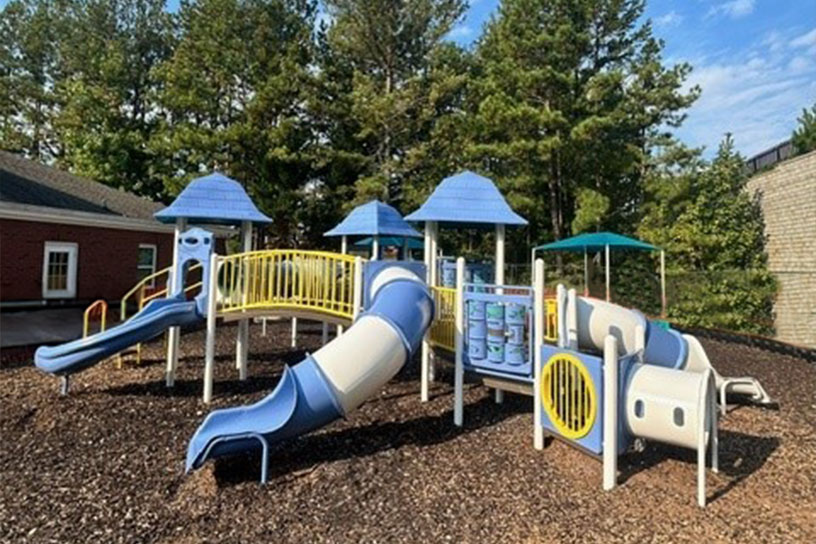Playgrounds are spaces where children's laughter and joyful adventures fill the air. However, beneath the excitement lies a critical aspect of safety: the playground surface. Did you know that a staggering 70% of all playground injuries result from falls to the safety surface? To ensure the safety of our little ones, rigorous safety standards have been established for protective surfacing by the American Society for Testing and Materials (ASTM).
Why Surface Testing Matters
The primary purpose of surface testing is to reduce the risk of severe head injuries resulting from falls. ASTM sets minimum impact attenuation requirements for playground surfaces, whether they are unitary-solid or loose-fill. Understanding two key metrics in surface testing is crucial:
G-Max (Peak Deceleration): This measures the peak deceleration of the head during impact and should not exceed 200 times the acceleration due to gravity. In simpler terms, it assesses how "soft" or "hard" the surface is upon impact.
HIC (Head Injury Criterion): HIC evaluates the time duration over which the head decelerates and should not exceed 1,000. It considers the time it takes for the head to come to a stop after a fall.
Meeting these standards is vital to protect children from serious head injuries while playing.
Challenges in Surface Testing
Surface testing doesn't conclude once a playground is installed and ready for play. Instead, it's a dynamic and ongoing process, deeply intertwined with the ever-changing conditions of playgrounds and parks. Understanding the potential challenges in surface testing is essential to maintaining the safety of these vital play spaces.
Environmental Factors at Play
One of the foremost challenges in surface testing lies in the environment itself. Playgrounds and parks are exposed to a multitude of natural elements that can significantly impact the safety of the surface. Here's how:
- Humidity - The level of moisture in the air can vary greatly, and this can affect the properties of the playground surface. High humidity may lead to compacting of loose-fill materials, potentially reducing their ability to cushion falls. Conversely, low humidity might result in materials becoming less resilient, impacting their shock-absorbing capacity.
- Air Temperature - Temperature fluctuations, from scorching summer heat to freezing winter cold, can alter the consistency of the surface. Extreme temperatures can cause solid surfaces to expand or contract, potentially affecting their impact attenuation properties.
- Solar Degradation - The constant exposure to sunlight can gradually degrade surfacing materials over time. This can lead to changes in texture and resilience, ultimately impacting their ability to provide a safe landing for children.
The Vital Role of Regular Playground Inspections
To protect both owners/operators from liability and children from potential harm, inspections are required at the time of installation, in the field, and on a routine basis. These inspections ensure that the surface continues to meet safety standards and performs as expected.
Playgrounds are places where children's laughter and carefree play define the landscape. Yet, beneath the surface of fun and adventure, safety takes center stage. The role of playground inspections, particularly in the context of impact testing, is absolutely critical. It serves a dual purpose: to safeguard playground owners and operators from liability while ensuring the safety of the children who play there.
Liability Protection
Let's begin with the protection aspect. Playground inspections act as a shield against potential liability. When a playground is open to the public, whether in a park, school, or community area, there is a shared responsibility to ensure its safety. Owners and operators have a legal and ethical duty to provide a secure environment for children's play.
By conducting inspections, they demonstrate a proactive commitment to safety. In the event of an accident or injury, a thorough inspection record can serve as crucial evidence that safety measures were diligently undertaken. This documentation can play a pivotal role in protecting owners and operators from legal consequences and financial liabilities.
Ensuring Child Safety through Impact Testing
The heart of playground inspections lies in impact testing. This testing, which includes metrics like G-Max and HIC (as previously discussed), evaluates the playground's protective surfacing. It ensures that the surface continues to meet safety standards over time, especially in the face of wear, tear, and environmental factors.
- Safety Standards Adherence - Regular inspections validate that the playground surface adheres to industry safety standards. This means it maintains the required shock-absorbing capacity to reduce the risk of severe head injuries from falls, one of the most common playground-related accidents.
- Early Detection of Issues - Routine inspections serve as early detection systems. They identify signs of wear, damage, or changes in the surface's consistency that could compromise its safety. By catching these issues early, corrective actions can be taken promptly to maintain the surface's protective properties.
- Child-Focused Safety - The ultimate goal of impact testing through inspections is to ensure the safety and well-being of children. Playgrounds should be spaces where children can explore, learn, and have fun without fear of injury. Inspections contribute significantly to making this a reality.
The Right Timing for Inspections
Inspections aren't a one-size-fits-all affair; timing matters. They should be conducted at various critical junctures:
At Installation
The initial inspection at the time of installation verifies that the surface meets safety standards right from the start.
In the Field
Periodic inspections in the field ensure that the surface continues to perform as expected under real-world conditions.
Routine Basis
Routine inspections on a regular basis ensure ongoing safety, protecting children during their everyday play.
In essence, the role of playground inspections in impact testing is about more than just meeting regulatory requirements. It's about creating a safe and secure environment where children can be children—where their laughter can ring out freely, and their adventures can unfold without worry. Through these inspections, you ensure that every child's playground experience is marked not only by joy but also by safety and peace of mind.
Choose Safety, Choose Playground Guardian
If you're uncertain about the safety of your playground surface, don't leave it to chance. Contact the team of Certified Park Inspectors at Playground Guardian. Our experts are equipped to conduct comprehensive playground surface tests, ensuring that your playground remains a safe haven for children's play and exploration. Your peace of mind and your child's safety are our top priorities. Schedule a playground surface test with Playground Guardian today and protect the joy of play for generations to come.





